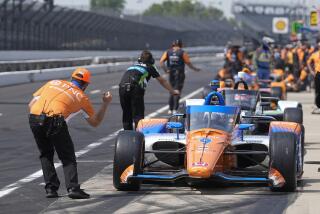Chevrolet Chaparral concept race car ignores all the rules
When General Motors designers created the Chevrolet Chaparral concept car for the Los Angeles Auto Show — and a digital version for the Gran Turismo PlayStation game — they tossed out all the rules they believe stifle innovation in auto racing.
Regulations designed to contain the expense of fielding an IndyCar race team also smother innovation in aerodynamics, suspension and engines, they said. Starting last year, for example, all cars must run on a twin-turbocharged V6. No V8s allowed. Forget about more exotic technology such as turbines.
Everybody’s racing to a rubric. Speeds have declined.
The four-lap average speed record — 237 mph — was set way back in 1996 by Arie Luyendyk during qualifying at the Indianapolis 500. Ed Carpenter, the pole driver in the race this year, won the position with a four-lap average of just over 231 mph.
“Motor sports now is so regulated with rules about weight and engine size,” said Clay Dean, director of global advanced design for General Motors. “The ability to freely innovate is challenged.”
Car racing is popular now, Dean said, but will the kids who have grown up in the digital age like it in two decades? Boxing was once immensely popular too.
“Motor sports used to be daring, risky and innovative,” Dean said. “That spirit is what we are trying to rekindle with the Chaparral concept car. A younger audience today loves a space with no rules.”
He said the Chaparral 2X VGT concept envisions what a race car would be like in 2030.
For inspiration GM looked back to its partnership with Chaparral Racing five decades ago to recapture the spirit of innovation that should shape future race cars, he said.
Race car drivers Jim Hall and Hap Sharp turned Chaparral into a household name in the 1960s, highlighting innovations that upset historically dominant international race teams. They pioneered composite monocoque chassis, lightweight-alloy powertrain systems, automatic transmissions for racing and progressive and active aerodynamics.
Some of the technology packed into the Chaparral 2J was banned by the Can-Am race series after other race teams complained.
Although it is just a static model, the Chaparral 2X VGT concept would also get banned pretty quickly.
There’s no engine or transmission. Instead, it features a mid-mounted laser that “hyper” heats air to create thrust, Dean said. Although it seems like fantasy, the same propulsion system is under consideration as a way to hurl small satellites into space.
“Sure, it does not exist in the automotive world, but who wants to do another aluminum V8?” Dean asked.
The race car has a stiff, light composite chassis. The driver fits face down with arms and legs splayed toward the wheels.
“Think of it as a race car version of a flying wing suit,” Dean said. “You are one with the device.”
It is this type of approach that GM hopes will grab the attention of younger car buyers.
“They don’t know as much about Chevrolet as we would like them to know,” Dean said.
The dynamic-looking car and its role in the Gran Turismo game should make an impression on the younger set, Dean said.
“The legend and legacy of Chaparral Racing is as a pioneer, with no inhibitions about doing things that have not been done before,” Dean said. “That’s a great message for Chevrolet.”
Twitter: @latimesjerry







